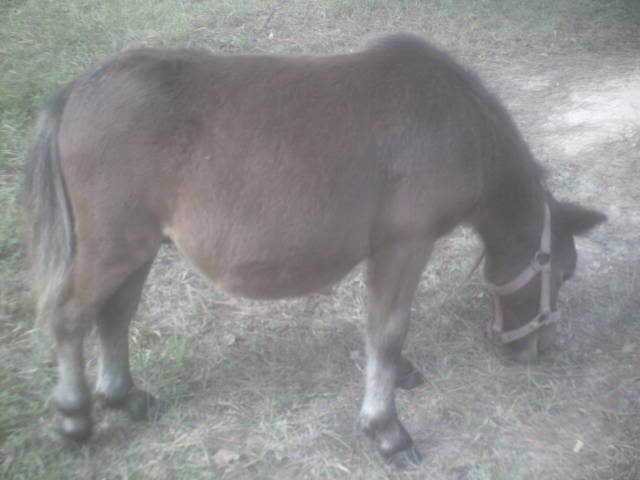WolfLady, your little man is not "plump" he is suffering from not enough nutrition due to his growth process/needing more quality feed. If you look and feel closely, you will notice that the bony structures over his back and hips are quite easily seen and even more easily felt. These should be covered with a layer of fat and muscle, and it will take some months to get him back into shape. It's common for little, growing ones to have this problem, so don't feel bad, just be glad you caught it and can do something about it. His dullish coat is another sign that he's needing some feed put into him.
The large belly is not from early weaning. My foals are often weaned around 4 months and I have never had one get that large of a belly. It will respond to more and better feed as well as a good quality worming program/rotation.
Increase his development (a Junior formulated feed like Purina or something similar) feed, get him a good quality hay, a mineral or salt block (as indicated by the feed label for the brand you use). He will even out his little round belly and his topline will look much better.
Whatever you are feeding now, increase it by a little at a time until you are at a level which is good for the manufacturer's directions (usually they give feeding guidelines on the tags for the feed or the website, which involves a weight on the horse and the feed, such as 1 lb. per hundred lb. of horse, and guessing your guy might be 100 lb. or thereabouts, I would be feeding him at least 1 lb. per day of the feed, if that is what they say, for example).
I would add soaked beet pulp, also, as it tends to get them filled out a little more quickly.
The worming is a good thing to address, and you might want to run this by your vet, and do not use the brand Quest, no matter what, as it is not safe for Miniatures.
I start my ground manners training from birth, and a foal/colt needs to be mindful of your space, as in not crowding or bumping you, and never biting or kicking, etc. Pinning his ears at you is the beginning of aggression and should not be tolerated. If you keep reminding him as he grows and tries his new tricks, you should be able to better keep him in check. Consistency and patience is the key, much as in human children.
I don't "work" my weanlings other than those above things and teaching them to "stand" for halter, as well as patience when tied.
I end up feeding my horses about three to four times a day, but I have that luxury beings as I or someone else is here almost constantly.
I usually feed the grain two to three times a day depending on time of year, and the hay I parcel out over several feedings. My weanies get free choice, as in if they eat it all up in a few hours' time, I will put more out and they have a poor quality pasture to graze on in the meantime, since it's admittedly poor, I supplement with a high quality orchard grass hay.
If he were mine, I would geld him and enjoy him as a pleasure horse or a show horse in that capacity.
Later on down the road, if you decide to breed, you can take all you've learned in the meantime and find just the right stallion to breed to your mare, it's really fun stallion shopping for breedings!
Hope this helps.
Liz M.
 . I am proud to have him and want to do not just good by him but great. To do so I need to learn. :new_shocked:
. I am proud to have him and want to do not just good by him but great. To do so I need to learn. :new_shocked:




















































